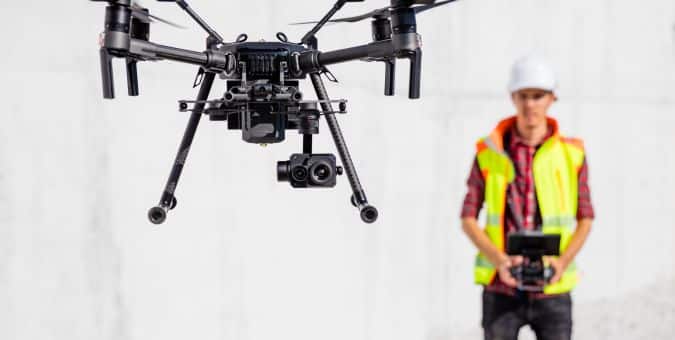Regulatory considerations
Dealing with the regulatory landscape for commercial drones can be a complex task as it varies from country to country and even region within a country. This section will focus on her two main regions of regulation: the United States and the United Kingdom. It’s important to remember that laws change, and staying up to date with the latest regulations from the authorities is essential.
America
In the United States, the Federal Aviation Administration (FAA) is the governing body responsible for regulating all civil aviation, including the use of commercial drones.
Commercial drone operators must: FAA’s Part 107 Rule (Small UAS Rule), covers drones weighing less than 55 pounds (approximately 25 kilograms) performing non-recreational operations. Key aspects of Part 107 include:
Commercial drone pilots must obtain a remote pilot certificate from the FAA and must pass an aviation knowledge test.
The drone must always be within the pilot’s line of sight (VLOS).
Drones may not be flown over persons not directly involved in the operation of the drone, over moving vehicles, or at night (unless equipped with specific anti-collision lighting).
Maximum altitude is 400 feet above ground (AGL) or within 400 feet of structure.
Top speed is 100 miles per hour (87 knots).
Exemptions may be requested for activities not covered by Article 107. Additionally, drones used for certain operations such as Beyond Visual Line of Sight (BVLOS) must be registered with the FAA.
England
in the UK, Civil Aviation Authority (CAA) Regulates the use of commercial and recreational drones. The main regulations regarding commercial drones are:
Commercial drone pilots must obtain an operating license from the CAA and must pass a theory test and a physical flight evaluation.
There are different categories of flights: open, specific and certified. Most commercial activities fall into certain categories and require an operating permit.
Drone pilots must not fly above 400 feet.
Drones must not be flown within 50 meters of any person or object not under the pilot’s control. Also, he must not fly within 150 meters of crowded areas or organized outdoor gatherings of more than 1,000 people.
Similar to the FAA in the United States, certain operations such as non-visual observation require additional clearance from the CAA.
The Importance of Responsible and Legal Drone Operations
While the use of drones brings enormous benefits, it also raises concerns about safety, privacy and security. Incidents such as near misses with manned aircraft, invasion of privacy, and the use of drones for illegal activities highlight the importance of responsible and legal drone operations.
Complying with regulations is important not only to maintain safety, but also to ensure the continued growth and acceptance of the drone industry. Irresponsible use of drones can lead to accidents, invasion of privacy, and other undesirable consequences, resulting in increased regulation and even public backlash against drone technology.
It is also important to note that serious penalties such as fines and imprisonment may be imposed for non-compliance with regulations. Therefore, before embarking on any commercial drone activity, it is imperative that you understand and comply with relevant laws and regulations and operate your drone in a safe and responsible manner.
please note
The information contained in this blog post, including references to regulations and legal considerations regarding the use of commercial drones, is provided for general informational purposes only. This article is not provided as legal advice of any kind and we cannot guarantee that the information is accurate, complete or up-to-date. While we strive to provide accurate and timely information, laws and regulations change frequently and the application of a particular law may vary significantly depending on the specific facts and circumstances involved.
Accordingly, the information provided here should not be used as a substitute for legal advice from a licensed attorney authorized to practice within your jurisdiction. If you have any legal questions or concerns, always consult your local aviation authority with jurisdiction over drone safety, use the services of a licensed drone operator, or seek the advice of a qualified attorney. please.
We expressly disclaim any liability for any action taken or not taken based in part or in whole on the content of this blog post. Use of the information provided herein does not create an attorney-client relationship between you and us.
final thoughts
In this blog post, we have explored the transformative impact of commercial drones across industries, from filmmaking and agriculture to real estate and emergency services. We have taken a deep dive into some of the top commercial drones on the market in 2023, highlighting the key factors to consider when choosing a drone for your business.
Regulation is important in this context and we have emphasized the importance of understanding and complying with these rules. We reviewed US and UK regulations to highlight a common global focus on safety, privacy and compliance.
With advances like AI integration and swarm technology, the future of commercial drones is bright, paving the way for even more disruptive possibilities. We encourage businesses to consider how commercial drones can enhance their operations and provide greater efficiency, cost-effectiveness and a unique perspective.
As we navigate this technological revolution, through careful selection and responsible operation, commercial drones can become a valuable tool in business, pushing boundaries and opening up a world of opportunities.
